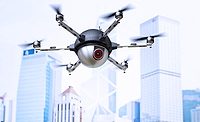Security on the go: The next generation of vehicle protection

We have been transporting valuable goods or people for centuries, caravans travelling the silk road, stagecoaches crossing the American west, and the movement of Kings, Queens and Presidents. And, since the beginning, there has always existed the need to protect those goods and people in opposition to forces determined to steal or harm the cargo. The technology employed to attack and defend ground transportation of valuables is ever evolving. The first armored vehicle was envisioned by Leonardo DaVinci in 1485 in a sketch as a circular wheeled platform with light canons arranged around the circumference. The first armored vehicle built to transport valuables in North America was a stagecoach fitted with a steel plated exterior built by the Cheyenne and Black Hills Stage Company circa 1870.
Despite this advance, looters found a way to defeat it resulting in one of the largest stagecoach robberies. Rolls-Royce introduced the first armored vehicle for personnel transport in 1914 leading to Mercedes Benz’s development of the Nurburg 460 used to protect Pope Pius XI in 1930.
The advancement of quantum physics in the early 20th century led to today’s highly sophisticated advanced technologies used to secure ground transport and also, the ones used to defeat those measures.
Satellite/cellular communication, interactive armor panels, optic-fire source detection, night vision, drones, remote monitoring and biometrics are all examples of technologies embedded in the threat mitigation systems of today’s ground transport vehicles.
All of these technologies are integrated in service of determining the key data needed to monitor and successfully deliver the cargo. Of primary importance is having as much detailed information about any threat and the environment in which it is occurring and second to have real time information about how to defeat or escape the threat.
At the heart of leading ground transport security systems are secure, encrypted bi-directional communications, on board intelligent sensing devices and remote monitoring and control systems providing instant situational analysis and response information.
Advanced diagnostic technologies with wireless capability, can be used to remotely monitor vehicles continuously. This is especially important for large and/or multinational fleets. Every aspect impacting the operation of the vehicle including its operational state, the personnel on board, the conditions of the vehicle interior and most importantly the identification of threats in the surrounding perimeter can be relayed to a remote server/computer and monitored. The information gleaned from this system can then be used to remotely activate or deactivate a wide range of functions on the vehicle.
These systems can also activate specific pre-defined emergency modes such as “Hijack” or “Assassination Attempt” which immediately initiates the deployment of pre-defined procedures thereby eliminating possible catastrophic outcomes resulting from delay or confusion about how to respond to the emergency.
The deployment of sensing and surveillance technologies advance the capability of the operator or operation leadership to transition from a position of being reactive to live threats to a proactive position able to identify threats before taking catastrophic damage from a strike.
The standard practices for emergency response, typically in use by fleet owners, cannot even remotely predict all possible scenarios. Leaving the operators and cargo in dangerous and vulnerable situations. The integrated use of night vision optical systems, drones and impact sensing systems can provide vital information about the location, nature and force of a threat, necessary for the rapid deployment of an escape or mitigation strategy. A strategy with a high probability of success and known risks.
Essential to the successful deployment of all of these technologies and the security of the vehicle cargo is some form of communication, person to person, device to device, person to device. Communications in the security realm are largely based in two platforms; satellite or radio frequency (mobile, wireless and IoT all operate on radio frequency). Radio frequency (RF) devices are easily compromised if left unprotected. These devices can be hacked to exfiltrate voice, video and computer data right through firewalls.
The use of virtual private networks (VPN) provides minimal protection whereas secure access service edge (SASE) system architecture can securely identify users and devices to defeat hacking threats. Because cellular communications are not always available in all locations it is necessary to have redundant or alternate satellite technology to transfer data and messages. Satellite communications are also vulnerable to hacking or jamming of the signal. These threats can be defeated through the use of robust satellite signal technologies that and through similar encrypted security technologies to SASE.
When the Cheyenne and Black Hills Stage Company built its armored stagecoach, it relied on brute force to protect the cargo, but it was defeated by neutralizing the driver and shotgun allowing the threat to seize control. Brute force is no longer a viable strategy for securing valuable personnel or goods being transported over ground. Today and in the future, the security of ground transportation will rely heavily on sophisticated integration of leading-edge technologies. To achieve this and stay ahead of evolving threats, companies responsible for the safekeeping of cargo and personnel will require partnerships with firms that engage in ongoing commitment to the research and development of those technologies and integration strategies.
Looking for a reprint of this article?
From high-res PDFs to custom plaques, order your copy today!





.jpg?height=200&t=1630084048&width=200)



